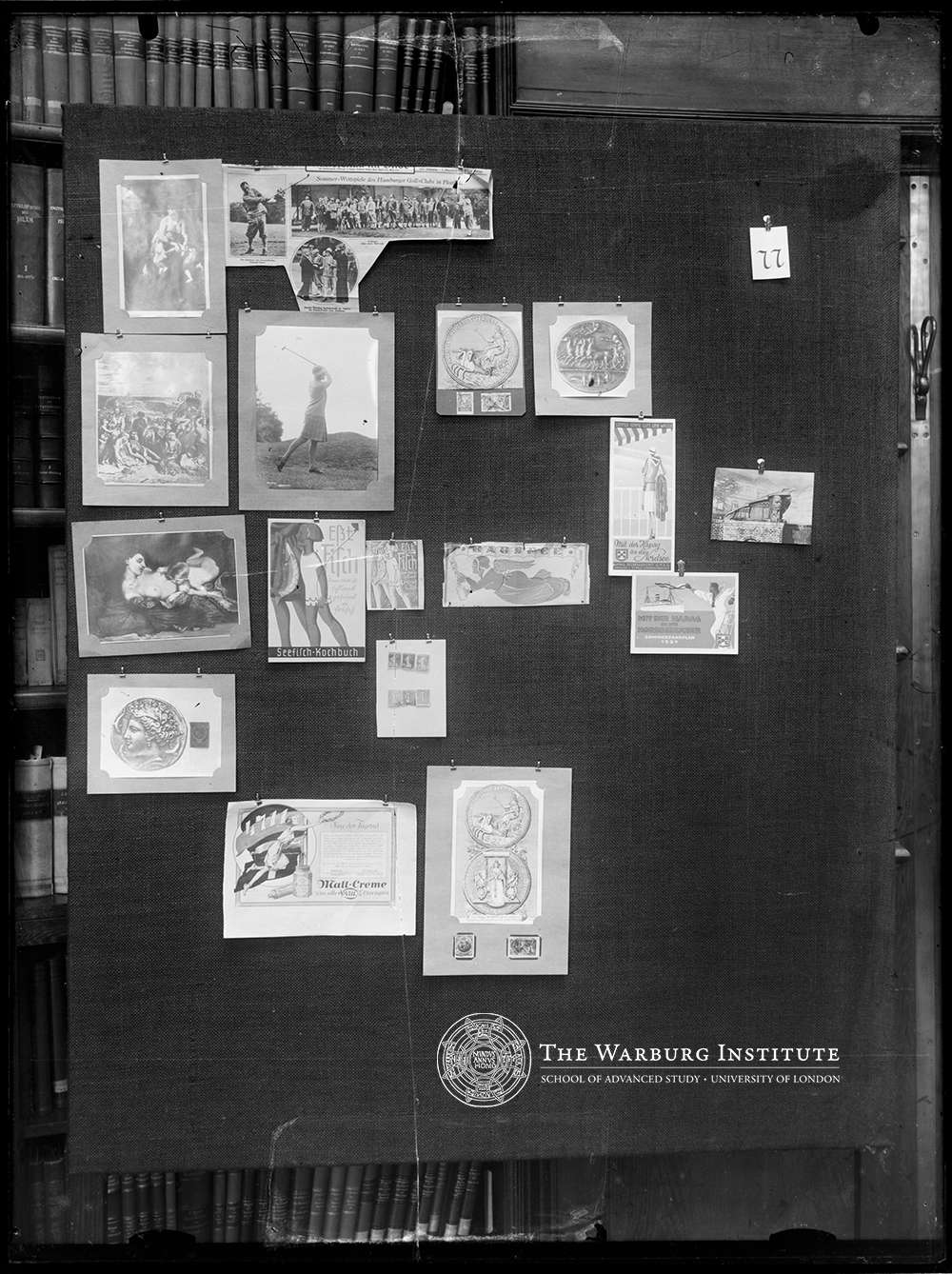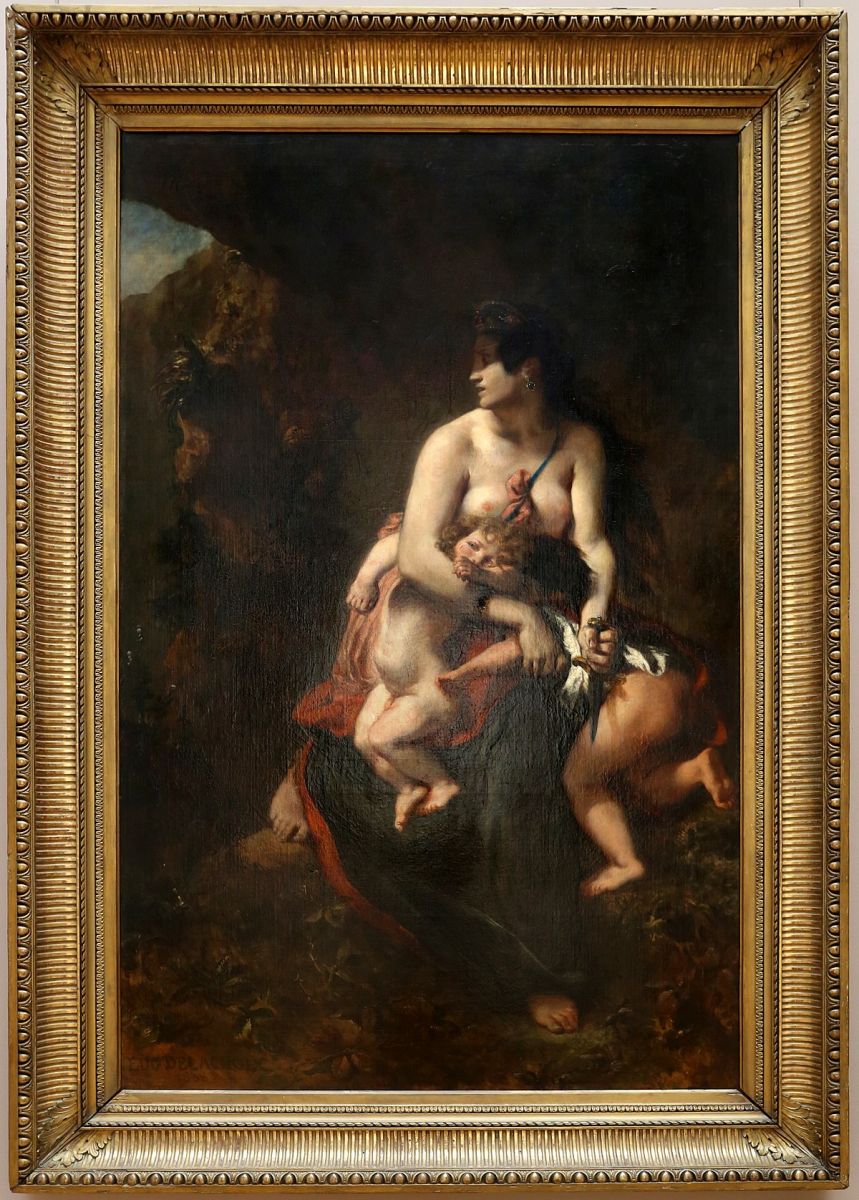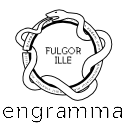Mnemosyne Atlas 77
Attualità della tradizione
Riemersioni dell’Antico in età moderna: in Delacroix la ripresa di temi e forme classici è parzialmente consapevole (Medea come Madre assassina; la madre nel Massacro di Chio come Aretusa, cfr. scene di Strage degli innocenti); altre figure sono recuperate in senso strumentale e allegorico (Nike nella pubblicità; Cerere-la Semeuse e il cocchio di Nettuno nei francobolli francesi e delle colonie); altre riemergono come engrammi (i giocatori di golf esprimono il pathos dionisiaco; ‘Tobiolo’ nella pubblicità); altre ancora come inversione formale (apoteosi rovesciata del monumento a Hindenburg, dove l’aquila non è veicolo di ascesa).
The classical tradition today
Re-emergence of Antiquity in the contemporary era. The revival of classical themes and forms is to some extent intentionally conceived, e.g. in Delacroix’s work (Medea as murderous Mother; the figure of the mother as Arethusa in the Massacre of Chios: see scenes of Massacre of the Innocents). In the 20th century, ancient figures are recovered both in a functional and allegorical sense (Nike in advertising; Ceres-La Semeuse and the chariot of Neptune in French and Colonial stamps); or they emerge as engrams (golfers expressing Dionysiac pathos; Tobias and the Angel in advertising); or they show an ‘energetic inversion’ (the inverted apotheosis of Hindenburg’s monument: here the eagle is not ascending to heaven).

Appunti di Aby Warburg (1929)
Sammelecho
Raccolta di eco.
Appunti di Aby Warburg e collaboratori (1929)
Delacroix Medea u. Kindermord. Marke: Barbados – Quos ego?, Frankreich – Semeuse, Arethusa. Nike und Tobiuzzolo in der Reklame. Hindenburg-Denkmal als umgekehrte Apotheose. Goethe “24 Beine”.
Delacroix, Medea e infanticidio. Francobolli: Barbados – “Quos ego?”, Francia – la Semeuse, Aretusa. Nike e Tobiolo nella pubblicità. Monumento a Hindenburg come apoteosi rovesciata. Goethe “24 gambe”.
Appunti di Gertrud Bing (1940 ca)
Eindringen der Pathos Motive in die Formensprache des tägl. Lebens. 1) Photographie von Tagesereignissen: Golfspielerin = Kopfjägerin 2) Reklame: Fisch = Tobias, 4711 = Ninfa "Hausfee" = Nike. 3) Marke: Neptun in Barbados, Mänade in Frankreich, Arethusa wo? (Barbados histor. Deszendenz nachweisbar: Staatssiegel Karls I. [sic!]) 4) Parkschmuck: Hindenburg unter den Schutz des Adlers, statt getragen vom Adler wie in der Apotheose der röm. Kaiser. Nicht dazugehörig: Delacroix 1) Medea 2) Pest wie derholt das Motiv vom Kind das bei der Toten Mutter noch Nahrung sucht.
L’ingresso di formule di pathos nel linguaggio gestuale della vita quotidiana. 1) Fotografia di eventi quotidiani: giocatrice di golf = cacciatrice di teste 2) Pubblicità: Pesce = Tobia, 4711 = Ninfa “fata domestica” = Nike 3) Francobollo: Nettuno alle Barbados, menade in Francia, Aretusa dove? (Derivazione discendenza storica delle Barbados è documentabile: sigillo di Carlo I) 4) Monumento nel parco: Hindenburg sotto la protezione dell’aquila, invece di essere portato dall’aquila come nell’apoteosi dell’imperatore romano. Non collegato: Delacroix 1) Medea 2) La peste ripropone il motivo del bambino che continua a cercare nutrimento dalla madre morta.
Letture di approfondimento
Altre letture
♦ K. Mazzucco, Tavola 77, in Camere con vista. Aby Warburg, Firenze e il laboratorio delle immagini, Catalogo della mostra (Firenze, Gallerie degli Uffizi, 19 settembre / 10 dicembre 2023), a cura di M. Faietti, E.D. Schmidt, G. Targia, G. Wolf et al., Firenze 2023, 256-259.
Notes by Aby Warburg (1929)
Sammelecho
Collection of echoes.
Notes by Aby Warburg and coll. (1929)
Delacroix Medea u. Kindermord. Marke: Barbados – Quos ego?, Frankreich – Semeuse, Arethusa. Nike und Tobiuzzolo in der Reklame. Hindenburg-Denkmal als umgekehrte Apotheose. Goethe “24 Beine“.
Delacroix: Medea and infanticide. Stam: Barbados - “Quos ego tandem”; France – the Semeuse, Arethusa. Nike and young Tobias in advertising. The Hindenburg Monument as reverse apotheosis. Goethe, “24 legs”.
Notes by Gertrud Bing (ca. 1940)
Eindringen der Pathos Motive in die Formensprache des tägl. Lebens. 1) Photographie von Tagesereignissen: Golfspielerin = Kopfjägerin 2) Reklame: Fisch = Tobias, 4711 = Ninfa "Hausfee" = Nike. 3) Marke: Neptun in Barbados, Mänade in Frankreich, Arethusa wo? (Barbados histor. Deszendenz nachweisbar: Staatssiegel Karls I. [sic!]) 4) Parkschmuck: Hindenburg unter den Schutz des Adlers, statt getragen vom Adler wie in der Apotheose der röm. Kaiser. Nicht dazugehörig: Delacroix 1) Medea 2) Pest wie derholt das Motiv vom Kind das bei der Toten Mutter noch Nahrung sucht.
The entry of pathos formulas into the gestural language of everyday life. 1) Photography of everyday events: golf player = headhunter 2) Advertisement: fish = Tobias, 4711 = Ninfa “Domestic fairy” = Nike 3) Postage stamp: Neptune in Barbados, maenad in France, Arethusa where? (Historical derivation from Barbados can be documented: seal of Charles I) 4) Monument in the park: Hindenburg under the protection of the eagle, instead of being carried by the eagle as in the apotheosis of the Roman emperor. Not related: Delacroix 1) Medea 2) The Plague reproposes the motif of the child who continues to seek nourishment from its dead mother.
Further Readings
Other Readings
♦ K. Mazzucco, Tavola 77, in Camere con vista. Aby Warburg, Firenze e il laboratorio delle immagini, Catalogo della mostra (Firenze, Gallerie degli Uffizi, 19 settembre / 10 dicembre 2023), a cura di M. Faietti, E.D. Schmidt, G. Targia, G. Wolf et al., Firenze 2023, 256-259.

1. Eugène Delacroix, Medea, dipinto, 1838 (Lille, Musée des Beaux-Arts)
2. Gare estive del golf club amburghese di Flottbek, ritaglio dall'"Hamburger Fremdenblatt" n. 208, edizione serale del 29 luglio 1929, p. 9 (particolare)
3. Eugène Delacroix, Il massacro di Chio, dipinto, 1824 (Paris, Musée du Louvre)
4. Fotografia della campionessa di golf Erica Sell-Schopp, da "Frau und Gegenwart"
5a. Carlo II come Nettuno, sigillo della casa reale inglese, rovescio, 1662
5b. Francobollo delle Barbados con il Cocchio di Nettuno
5c. Francobollo delle Barbados con il Cocchio di Nettuno
6. Quadriga al galoppo con auriga incoronata da Nike, rovescio di decadracma siracusana, Aretusa 400-390 a.C., Paris, Bibliothèque Nationale, Cabinet des Medailles
7. Madre morta con bambino, copia di un particolare del Massacro di Chio di Eugène Delacroix, 1821-1824 (Prag, Nationalgalerie)
8. Mangiate pesce! Il libro delle ricette a base di pesce [titolo dell’immagine], manifesto anni Venti del 1900, Londra, Warburg Institute
9. Mangiate pesce! [titolo nell'immagine], inserzione pubblicitaria nelle "Hamburger Nachrichten", 15 aprile 1928
10. Hausfee (la fata domestica), pubblicità per carta igienica
11. Sommer, Sonne, Luft und Wasser. Mit der Hapag an die Nordsee (Estate, Sole. Aria e acqua, con la Hapag al Mare del Nord), pubblicità per la compagnia navale Hapag
12. Monumento a Hindenburg
13. Mit der Hapag in die Nordseebäder (con la Hapag nelle spiagge del Mare del Nord), frontespizio dell'orario estivo delle partenze della compagnia navale per il 1927
14. Semeuse, francobolli francesi
15. Aretusa, diritto di decadracma da Siracusa, 400-390 a.C., Paris, Bibliothèque Nationale, Cabinet des Medailles
16. Sieg der Jugend (Vittoria della giovinezza), pubblicità per la crema cosmetica "4711"
17. Carlo II come Nettuno, Caterina II, diritto e rovescio di un sigillo della casa reale inglese, 1662
18. Francobolli delle Barbados


77_1 | Eugène Delacroix, Medea, olio su tela (260 x 165 cm.), 1838. Lille, Musée des Beaux-Arts.
In Tavola: riproduzione fotografica.
77_1 | Eugène Delacroix, Medée furieuse (Also known as Medea about to Kill her Children), Oil on canvas (260 x 165 cm.), 1838. Lille, Musée des Beaux-Arts.
In the panel: photographic reproduction.

77_2 | Gare estive del golf club amburghese di Flottbek. Ritaglio dall'"Hamburger Fremdenblatt" n. 208, edizione serale del 29 luglio 1929, p. 9
In Tavola: ritaglio di giornale.
77_2 | Summer Games of Golf at Hamburg Golf Club in Floubek. Cutout from Hamburger Fremdenblatt no. 208, evening edition 29.7.1929, p. 9.
In the panel: newspaper print.

77_3 | Eugène Delacroix, Il massacro di Chio, , olio su tela (419 x 354 cm.), 1822-1824. Parigi, Musée du Louvre.
77_3 | Eugène Delacroix, Scènes des massacres de Scio, Oil on canvas (419 x 354 cm.), 1822-1824. Paris, Musée du Louvre.

77_4 | La campionessa di golf Erika Sellschopp, fotografia da "Frau und Gegenwart" (23 x 17 cm.), 1928.
In Tavola: riproduzione fotografica.
77_4 | Golf Champion Erika Sellschopp, Photograph (23 x 17 cm.), 1928.
In the panel: photographic reproduction.

77_5a | George Vertue, Carlo II come Nettuno (rovescio del sigillo della regina di Inghilterra, Caterina di Braganza), incisione (23,3 x 15,2 cm.), 1705-1750 c.
77_5b | Re George V come Nettuno, Francobollo delle Barbados da 1 penny (2,8 x 3,4 cm.), 1925.
77_5c | Re George V e Inghilterra su un carro trainato da cavalli marini, Francobollo inglese da mezza corona (4,4 x 2,8 cm.), 1913.
In Tavola: riproduzione fotografica.
77_5 | George Vertue, Charles II driving a chariot drawn by sea horses (Reverse of The Seal of Katherine of Braganza, Queen of England), Engraving (23.3 x 15.2 cm.), 1705-1750 c.
77_5b | King George V as Neptune, Stamp from Barbados with British penny denomination (2.8 x 3.4 cm.), 1925.
77_5c | King George V and England in the Shell Carriage, Great Britain Stamp with half crown denomination (4.4 x 2.8 cm.), 1913.
In the panel: photographic reproduction.

77_6 | Quadriga al galoppo con auriga incoronata da Nike (rovescio di decadracma siracusana), moneta d’argento (d.: 3.6 cm.), 400-390 a.C. Parigi, Bibliothèque Nationale, Cabinet des Medailles.
In Tavola: riproduzione fotografica.
77_6 | Quadriga driven by a charioteer, holding reins and kentron, above, Nike flying to crown him (obverse of a Dekadrachm from Syracuse, Sicily), Silver coin (d.: 3.6 cm.), 400-390 BC. Paris, Bibliothèque Nationale, Cabinet des Medailles.
In the panel: photographic reproduction.

77_7 | Eugène Delacroix, Madre morta con bambino, (studio di un dettaglio de Il massacro di Chio), olio su tela (94 x 132 cm.), 1821-1824. Praga, Nationalgalerie.
In Tavola: riproduzione fotografica.
77_7 | Eugène Delacroix, Dead mother with child (Study of a detail of The massacre at Chios), Oil on canvas (94 x 132 cm.), 1821-1824. Prague, Nationalgalerie.
In the panel: photographic reproduction.

77_8 | Eßt Fisch (Mangiate pesce!), manifesto (20,2 x 13,5 cm.), 1928. Dal rontespizio del libro delle ricette Seefisch-Kochbuch. Eßt Fisch dann bleibt ihr gesund und frisch, Berlin, 1928. Londra, Warburg Institute.
In Tavola: riproduzione fotografica.
77_8 | Eßt Fisch (Eat Fish), Poster (20.2 x 13.5 cm.) From the cover of: Seefisch-Kochbuch. Eßt Fisch dann bleibt ihr gesund und frisch, Berlin: Reichs-AusschuB für Seefischpropaganda e.V., n.d., 1928. London, Warburg Institute.
In the panel: photographic reproduction.

77_9 | Eßt Fisch (Mangiate pesce!), inserzione pubblicitaria nelle "Hamburger Nachrichten", 15 aprile 1928.
In Tavola: ritaglio di giornale.
77_9 | Eßt Fisch (Eat Fish), Advertisement in: Hamburger Nachrichten, 15.4.1928.
In the panel: Newspaper print.

77_10 | Hausfee (la fata domestica), confezione (1,5 x 21 cm.), inizio del XX sec.
In Tavola: riproduzione fotografica.
77_10 | Hausfee (House Fairy, Toilet paper packaging with Victoria motif, Packaging (1.5 x 21 cm.), Early 20th century.
In the panel: photographic reproduction.

77_11 | Sommer, Sonne, Luft und Wasser. Mit der Hapag an die Nordsee (Estate, Sole. Aria e acqua, con la Hapag al Mare del Nord), pubblicità per la compagnia navale Hapag (22,7 x 9,5 cm.), 1929.
In Tavola: riproduzione fotografica.
77_11 | Sommer, Sonne, Luft und Wasser. Mit der Hapag an die Nordsee (Summer, Sun, Air and Water. With Hapag to the North Sea), Timetable for the Hapag Ferries (22.7 x 9.5 cm.), 1929.
In the panel: photographic reproduction.

77_12 | Rudolph Gangloff, Monumento a Hindenburg, cartolina di Carl Schunemann e foto di Franz Schensky (10,5 x 14,8 cm.), 1929.
In Tavola: riproduzione fotografica.
77_12 | Rudolph Gangloff, Hindenburg Monument in Heligoland, Intaglio postcard printed by Carl Schunemann, photograph by Franz Schensky (10.5 x 14.8 cm.), 1929.
In the panel: photographic reproduction.

77_13 | Mit der Hapag in die Nordseebäder (con la Hapag nelle spiagge del Mare del Nord), frontespizio dell'orario estivo delle partenze della compagnia navale per il 1927 (2 x 16 cm.).
In Tavola: riproduzione fotografica.
77_13 | Mit der Hapag in die Nordseebäder (With Hapag to the North Sea Baths), Cover of the Hapag Ferries timetable (2 x 16 cm.), 1927.
In the panel: photographic reproduction.

77_14 | Semeuse (La seminatrice), francobolli francesi, 1900-1930.
In Tavola: riproduzione fotografica.
77_14 | Semeuse (The Sower), French postage stamp, 1900-1930.
In the panel: photographic reproduction.

77_15 | A sinistra: Aretusa (diritto di decadracma siracusana), moneta d’argento (d.: 3.6 cm.), 400-390 a.C. Parigi, Bibliothèque Nationale, Cabinet des Medailles.
A destra: francobollo francese (d.: 3,6 cm.), q885.
In Tavola: riproduzione fotografica.
77_15 | Left: The nymph Arethusa (designed by Kirnon and Euinatos, among others; Dekadrachm from Syracuse, Sicily), Silver coin (d.: 3.6 cm.), 400-390 BC. Paris, Bibliothèque Nationale, Cabinet des Medailles.
Right: French Tax Stamp (d.: 3.6 cm.), 1885.
In the panel: photographic reproduction.

77_16 | Sieg der Jugend (Vittoria della giovinezza), pubblicità per la crema cosmetica "4711" (19.5 x 27 cm.), 1928.
In Tavola: riproduzione fotografica.
77_16 | Sieg der Jugend (Victory of the Youth), Advertisement for 4711 Matt-Creme (body lotion), (19.5 x 27 cm.), 1928.
In the panel: photographic reproduction.

77_17 | George Vertue, sigillo della regina di Inghilterra, Caterina di Braganza: Carlo II come Nettuno, e la regina Caterina II stante), incisione (23,3 x 15,2 cm.), 1705-1750.
In Tavola: riproduzione fotografica.
77_17 | George Vertue, Seal of Catherine of Braganza, Queen of England Charles 11 as Neptune, driving a chariot drawn by a sea horse (reverse). Standing figure of the Queen (obverse), Engraving (23.3 x 15.2 cm.), 1705-1750.
In the panel: photographic reproduction.

77_18 | Re George V come Nettuno, Francobollo delle Barbados da 1/4 penny (2,8 x 3,4 cm.), 1913-1916; e Re George V e Inghilterra su un carro trainato da cavalli marini, Francobollo inglese da 10 scellini (4,4 x 2,8 cm.), 1916.
In Tavola: riproduzione fotografica.
77_18 | King George V as Neptune, Stamp from Barbados with British 1/4 penny denomination (2.8 x 3.4 cm.), 1913-16. And King George V and England in the Shell Carriage, Great Britain Stamp with ten crown shillings (4.4 x 2.8 cm.), 1916.
In the panel: photographic reproduction.

